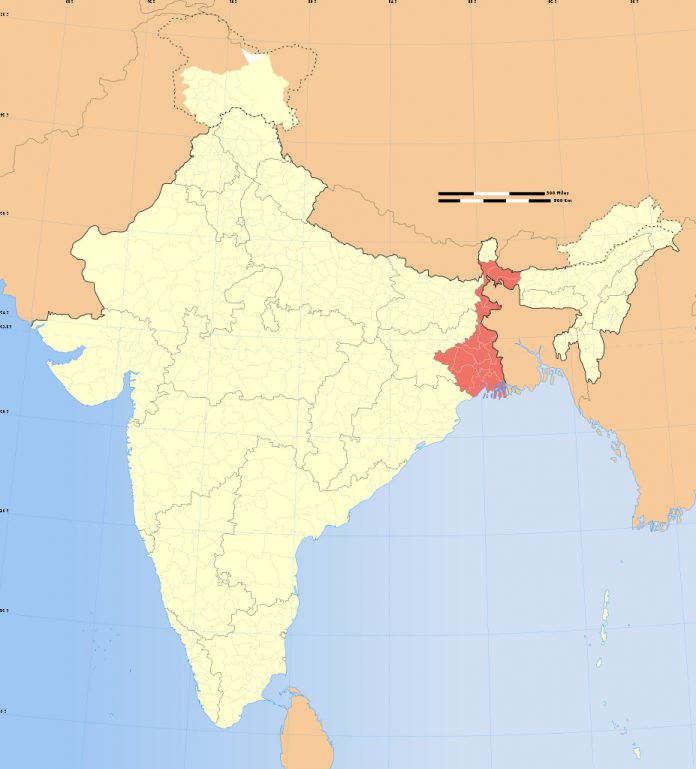It has been more than half a decade since Prime Minister Narendra Modi launched the Act East Policy which marginally has proven to be a step ahead of the previous Look East Policy. The 2014 Policy has definitely expanded the horizons of economic integration, repositioning India’s interest from just Southeast Asia to, East Asia and the Pacific. In furthering the Act East Policy, Bengal as a region has been very crucial, since Bengal is the pivot for any activity that takes place vis-a-vis the Act East Policy. This article delves deeper into why Bengal as a region is considered as a pivot for the Policy.
Since the Act East policy was launched, several connectivity projects have been initiated, be it the Bangladesh-China-India-Myanmar Economic Corridor or the Kaladan Multi-Modal Transit Transport Corridor. It is observed that such connectivity projects that connect India with Southeast Asia majorly cross Bengal.
West Bengal is situated in Eastern India and shares its borders with Jharkhand, Bihar, Odisha, Sikkim and North Eastern States. The State also shares international borders with Nepal, Bhutan and Bangladesh. The Bay of Bengal is in the South of the state. West Bengal occupies an important strategic location in East India, owing to the long international border that it shares with foreign States. Locational advantages suggest that it should play a crucial role in India’s pursuit of increased trade with other Asian countries. As West Bengal is close to Bangladesh, Myanmar, Thailand and a number of other East Asian and Southeast Asian countries, it has the potential to become a gateway for India’s Act East Policy.
Kolkata, the capital of West Bengal is interestingly connected to many international maritime and road connectivity projects. For example, the Bangladesh-China-India-Myanmar economic corridor hopes to connect Kolkata with Kunming that will cross Bangladesh and Myanmar as well. Apart from this, Bengal is very much connected to the Asian Highway Network, Kaladan Multi-Modal Transit Transport Project and to the Zolkawtar-Rhee route. It is also anticipated that Kolkata will play a massive role in the New Silk Road trade route.
There are several reasons as to why Bengal is being considered as a pivot in India’s Act East Policy, ranging from its strategic location to connectivity infrastructure and also its maritime potential. On a strategic line, Bengal is considered to be a gateway to Southeast Asia and Northeast India, and also being a connecting hub for mineral-rich Indian states like Jharkhand, Orissa and Chhattisgarh. Bengal also acts as the port of entry for landlocked states of Central India and other nations like Nepal and Bhutan. As far as the connectivity infrastructure is concerned, Bengal has the 3rd largest road network in the country, with major reach to national inland waterways. Having two international airports, one at Kolkata and the other at Bagdogra along with international maritime connectivity via the Kolkata and Haldia port, Bengal features exemplary global connectivity.
The Sagar Port (under construction), Tajpur Port (proposed to be built by 2020) and the small Kulpi port, will only boost Bengal’s trade figures. The entire stretch of the Ganges between Allahabad and Haldia has been declared as National Waterway-1 (NW-1) by the Government of India. The Waterway spans across a distance of 1,620 km. As of November 2018, the first container movement happened on NW-1 when PepsiCo moved its 16 containers from Kolkata to Varanasi on the inland vessel MV RN Tagore. Thus, a lot of new developments can be seen vis-a-vis Bengal which will only open more prospects for India’s Act East Policy.
This article has extensively highlighted that Bengal has been integral in the implementation of Act East Policy. I would also like to underscore how Bengal is significant for the upcoming projects and plans under Act East Policy, as well. The article already mentioned above that the major shift from the Look East Policy to Act East Policy has been the expansion to the Pacific, cardinal focus being on Australia. Bengal, again was the pivot in India-Australia relations when, in 2019 Australia opened a Consulate-General in Kolkata, keeping in mind the rise in several Australian firms that operate in Eastern India and tourism between the two countries has seen an upsurge in the past few years. Bearing in mind these two things, the Consulate-General which recently opened in Kolkata is having a positive impact between India-Australia relations and also on India’s Act East Policy.
Noting several factors, as mentioned above, clearly show us a picture of how Bengal has become a pivot for the Act East Policy, from a strategic point of view. Though, a lot of questions about Bengal being a pivot, in practice remain unanswered. How will Bengal be used in the connectivity projects that are planned in the Northeast Region? Will the state Government of Bengal be helpful in questioning authorities who are liable for the completion of the different projects under the Act East Policy, that connect through Bengal? With the hope that apart from the strategic importance of Bengal vis-a-vis the Act East Policy, certain positive measures taken on the front of governance and politics by the state Government of Bengal, will promote Bengal as a pivot for the Act East Policy, to a great extent.
The views and opinions expressed in this article are those of the author.
The author is pursuing his Bachelors in Political Science from Amity University, Kolkata. His research interests include the Middle East, primarily focusing on conflicts in the region and also Indian foreign policy.


